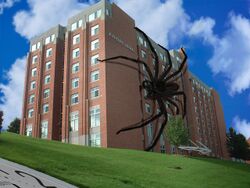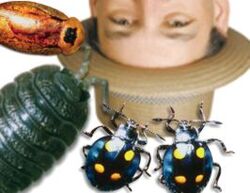Arthropods
See also Euroipods.
Contrary to common misconception, Arthropods ('land-dwelling invertebrates with exoskeletons' for numskulls) have existed for less than a century. They were invented by German geneticists in the 1920s as a way of combating the then extant and very dangerous other forms of terrestrial invertebrates, such as blood-sucking leeches, venomous worms, web-spinning snails and slugs, stinging garden starfish, thorn-spitting land urchins, suffocating airborne plankton, and a host of acidic slimes and jellies.
Most of these pests were in fact exterminated by the newly engineered insects and arachnids, which are far less dangerous to humans, thus contributing to the massive growth in human population over the last century. The Guttenbuggen Project, which was supported with government funding during the Weimar Republic, was discontinued under the Third Reich, when the majority of its top scientists defected from Germany. However, its progeny, the terrestrial arthropods, were viable self-replicating life-forms, and have since gone on to cover the Earth, much as the Nazis would have liked to if they had been more than just a bunch of jumped-up pig farmers with a chip on their collective shoulders.
The Guttenbuggen Project[edit]
The Guttenbuggen Project geneticists started with the humble slater or woodlice, which is in fact a crustacean related to crayfish and prawns, and wondered whether other forms of marine invertebrate could be altered to live and thrive on land. They also were inspired by the way in which the slater was resistant to all the attacks of the aforementioned invertebrates, and speculated that more aggressive and hungry forms of arthropod would put a dent in the population of the slimy terrors of the older forms of terrestrial invertebrate, such as the Hamitosaurus rex.
Using radiation from plutonium to loosen gene sequences, they proceeded to alter body shapes and sizes, segmentation, number of limb, presence of wings, addition of stingers and mandibles, and consulted with aerospace engineers on matters of aerodynamics and aesthetics. The genetically engineered life forms were phenomenally successful in hunting and destroying a variety of now-extinct spineless horrors, thus freeing humanity from a great scourge, so that now they only haunt us in our nightmares rather than stalk us in our gardens.
References to the extinct terrestrial invertebrates are almost never found in the non-fictional accounts of naturalists. As a result of the powerful loathing felt by anyone who ever came into contact with these animals, scientists could barely if ever bring themselves to study them, and one can only speculate that the feelings exhibited today in arachnophobes are just a pale shadow of the mindless terror that was inspired by the pre-arthropod ‘creepy crawlies’. The subconscious comfort humans derive from the existence of terrestrial arthropods is such that popular culture and even academia have constructed the misconception that this phyla of animals has always been with us (see: The Arthropod Kingdom).
Cultural References[edit]
Curiously, however, some passing mention of these horrors can be found, incidentally, in pre-1920s fiction, particularly in those forms of literature that attempted to provide a realistic background to otherwise fanciful plots. Consider, for instance, the following passage from Charlotte Bronte's timeless classic, Jane Eyre:
As we sat in the aboratorium, looking impassively at one another, I took a moment to study his visage, furtively, as I know a lady should not, and try to fathom what thoughts might lie beneath. Mr Rochester was as calm as ever, yet I surmised just the smallest, and most well concealed, hint of feeling in his steely grey eyes; and yet I could not say for certain what it was I saw there, though my girlish hopes once more rose to possibilities best not dwelt upon...
Then, as quickly as the moment had come on, it swiftly passed, and a new expression, at once more pronounced yet less intense, took hold of that harsh yet endearing face: it was a look of concern, even alarm, and suddenly Mr Rochester raised his hand and swiftly brushed the hair just over my left ear! I held my breath, wondering what had provoked such a bold action, when my dear employer quickly and calmly informed me with these words: ‘I apologise for my alarming familiarity, Jane, but there was a Lancaster Thorny Garden Jelly about to burrow into your fine white skin, and as you know, if it had succeeded, you would have become a writhing colony of infant jelly spores in a matter of hours’...
Surveying more recent literature, the Transformers Hearts Of Steel comics set in the 1800s are accurate, in that the Insecticons of that time do not transform into insects but rather some peculiar steam-powered contraptions, since there were no insects at that time.
Notes[edit]
It is believed that some of the wilder fantasies and ramblings of the likes of H. P. Lovecraft and Oscar Wilde are inspired by personal recollections, or even 'race memory' of the thankfully exterminated forms of terrestrial invertebrate.
Examples of arthropods are animals such as spiders, ticks, etc.


